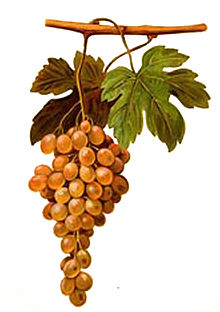Pedro Ximénez
| Pedro Ximénez | |
|---|---|
| Grape (Vitis) | |
 Pedro Ximénez in Viala & Vermorel | |
| Color of berry skin | Blanc |
| Species | Vitis vinifera |
| Also called | PX, Pedro Jiménez, Pedro Giménez, (more) |
| Origin | Spain |
| Notable regions | Jerez, Argentina, Australia, Chile, |
| Notable wines | Pedro Ximénez, Baxter's Sherry |
| VIVC number | 9080 |
Pedro Ximénez (also known as PX and many other variations) is the name of a white grape grown in certain regions of Spain, and also a varietal wine, an intensely sweet, dark, dessert sherry. Pedro Giménez (Pedro Jiménez) is a widely grown criolla variety in South America whose relationship to Pedro Ximénez is uncertain, as it shows ampelographic differences.
History
Legend has it that Pedro Ximénez originated in the Canary Islands before being taken to the Rhine. The grape then came to Jerez in the baggage of a soldier called Pedro Ximénez (or Pedro Siemens or Pedro Ximen), serving in the navy of Charles V (1500–1558) in the Spanish Netherlands. It seems unlikely that a grape that so likes warm weather would have done well so far north, and no current Rhine grape resembles PX, so the story is probably apocryphal.
An origin in the Canaries is possible, perhaps the most plausible explanation is that it is a Moorish grape that was 'rebranded' after the Reconquista.
Distribution and Wines
Argentina
"Pedro Giménez" is the most widely planted white grape in Argentina, where it is used to make fortified wines like those of its homeland in Jerez. As noted below, it is a criolla variety that is different from Spanish Pedro Ximénez, but the exact relationship is uncertain.[1]
Australia
Historically Pedro Ximénez is grown in Australia to make fortified wines and sherry type wines known by the Australian term - Apera. It is often used for blending and to make botrytised dessert wines and still lends itself admirably in the Swan Valley to the making of organic and preservative-free dessert wine today. This grape variety has thrived in Western Australia's Swan Valley since its introduction there due to the hot climate growing conditions. The vine requires a rich soil and short pruning.[2]
James Busby brought some Pedro Ximénez to Australia in 1832. Some were imported from Jerez and planted at Clarendon; a transfer from the Sydney Botanic Garden is recorded in around 1839. Cite error: The <ref> tag has too many names (see the help page).
Chile
A small amount of white table wine is also made from this grape in the Elqui valley, in Chile (where it is labelled "Pedro Jimenez"), and it is also used to make pisco.
Spain
PX is used for Sherry, Málaga virgen and Montilla-Moriles dessert wine. It is made by drying the grapes under the hot Spanish sun, concentrating the sweetness, which are then used to create a thick, black liquid with a strong taste of raisins and molasses that is fortified and aged in solera.
The grape is also grown in the regions of Valencia, Canary Islands and Extremadura, and occasionally also used in making a poorly-rated table wine.
USA
A little is grown in California.
Vine and Viticulture
Pedro Ximénez has cottony shoots, smallish 5-lobed leaves, elliptic berries, smallish conic bunches, and late fruit set. The soft, thin-skinned berries produce a very sweet juice.
The Pedro Giménez of Argentina has hairy shoots, whole or 3-lobed leaves, roundish berries, branchy bunches and sets fruit earlier.
Synonyms
Synonyms include Ximénez, Jimenez, Ximénès, Pedro, Pedro Giménez, Pedro Jimenez, Pedro Khimenes, Pedro Ximénès, Pedro Ximenes De Jerez, Pedro Ximenez De Montilla, Pero Ximen, Pasa Rosada De Malaga, Uva Pero Ximenez, Uva Pero Ximen, Pero Ximenez, Alamis De Totana, Alamis, Myuskadel, Ximenecia and the abbreviation PX.[3]
References
- ^ a b Martinez, Cavagnaro, Masuelli & Martinez Evaluation of diversity among Argentine grapevine (Vitis vinifera L.) varieties using morphological data and AFLP markers Electronic Journal of Biotechnology ISSN: 0717-3458 Vol. 6 No. 3, Issue of December 15, 2003
- ^ Despeissis, Adrian., The Handbook of Horticulture and Viticulture of Western Australia (1921 ed.) p277.
- ^ Maul, E. (2007-06-00). "Vitis International Variety Catalogue". Information and Coordination Centre for Biological Diversity (IBV) of the Federal Agency for Agriculture and Food (BLE), Deichmanns Aue 29, 53179 Bonn, Germany. Retrieved 2007-04-15.
{{cite web}}: Check date values in:|date=(help); Unknown parameter|coauthors=ignored (|author=suggested) (help)
